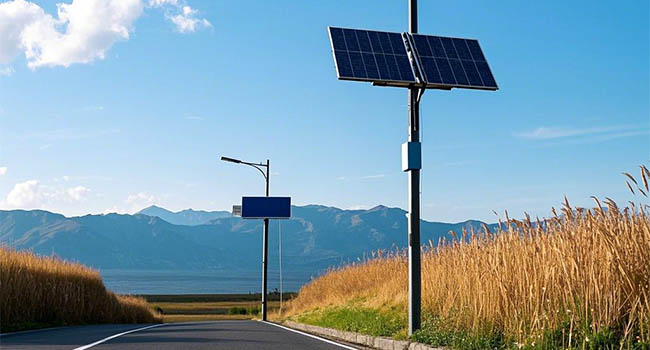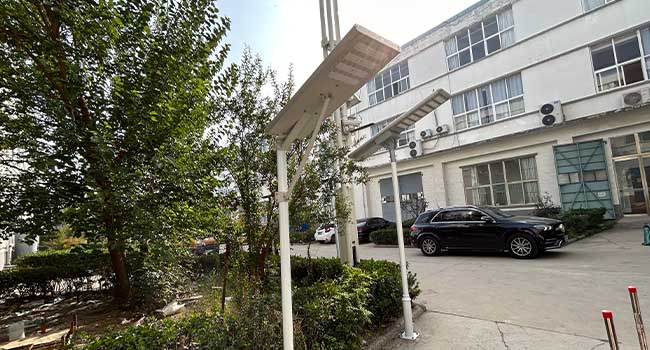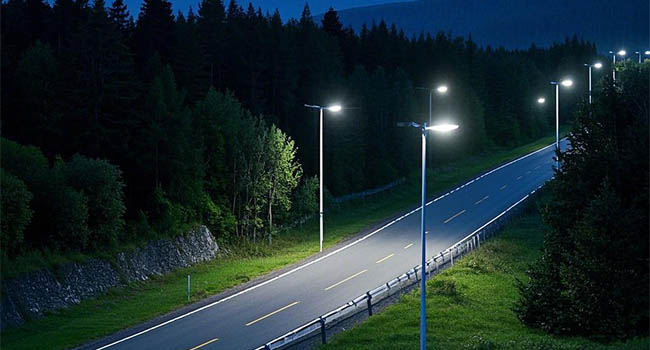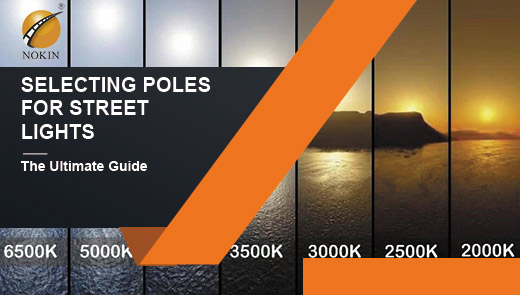How to Choose Solar Street Lights: Ultimate Guide
Mar 10, 2025
Solar street lights are becoming more and more popular in today's society. In Philippines, for example, thousands of solar street lights can be seen everywhere on the highways. Whenever night falls, these street lights are lit up to illuminate the road with clean, sustainable energy. In view of its wide application, how to correctly choose solar street lights is particularly critical, the next will be introduced to you in detail.

Why Are solar street lights so popular?
Cost-effective
Solar street lights utilize solar energy to convert into electricity, eliminating the need to pay high electricity bills. In the long run, this greatly saves on operating costs. For example, traditional street lights can cost hundreds of dollars per month in electricity expenses, while solar street lights can eliminate this expense altogether.Low Maintenance Requirements
Compared to the complex wiring maintenance and frequent bulb replacement of traditional street lights, the maintenance of solar street lights is much simpler. There is no complicated wiring system, which reduces the possibility of wiring failure. Moreover, the long lifetime of the LED light source reduces the frequency of bulb replacement.Renewable Energy
Solar energy is a renewable energy source that is inexhaustible. The use of solar street lights helps to reduce the dependence on traditional fossil energy sources, reduce carbon emissions, and has a positive significance on environmental protection.Suitable for remote areas
In remote areas, laying power lines is costly and difficult. The independent operation of the solar street light makes it unnecessary to rely on the power grid, and it can work normally as long as there is sunlight, which is very suitable for installation and use in remote mountainous areas, villages and other areas.No wires and cables
No need to lay wires and cables, which not only saves the cost of cable materials, but also reduces the investment of manpower and material resources in the construction process. At the same time, it avoids the safety hazards and maintenance costs caused by cable aging and damage.Factors to consider before buying solar street lights
Determine the lighting needs
Evaluate the lighting area
Measuring the area: For a rectangular area, determine the size of the area by measuring the length and width. For example, a parking lot with a length of 20 meters and a width of 10 meters has an area of 200 square meters.Distinguish between types of areas: Different areas have different lighting requirements. Parking lots are large and require uniform lighting to ensure the safety of vehicles and pedestrians, while narrow sidewalks have relatively low lighting needs, but need to be bright enough to guide pedestrians.
Defining Brightness Requirements
Brightness is usually measured in lumens (lm). Lighting luminance requirements vary considerably from area to area. Open areas like streets and parks require high levels of brightness, typically 5,000 - 10,000 lumens, for the safety of pedestrians and vehicles, while smaller areas such as small neighborhood roads and courtyards, 2,000 - 5,000 lumens are sufficient.Understanding Solar Panel Efficiency
Solar Panel Types
Panel Types Features| Battery Type | Features |
| Multi-Crystalline Solar Panel | Relatively low cost, mature production technology, conversion efficiency generally between 15% - 20% |
| Mono-Crystalline Solar Panel | Higher conversion efficiency, can reach 20% - 25%, often black in color |
| Amorphous Solar Panel | Good flexibility, can be made into various shapes, low cost, but conversion efficiency is generally between 6% - 12% |
Monocrystalline silicon panels excel in efficiency and are able to convert solar energy into electricity more efficiently, generating more power under limited light conditions.
Energy Absorption
You should choose panels that have a high energy absorption capacity and can work well even on cloudy days or in low light conditions. These panels are usually made of advanced materials and technologies that can absorb and utilize the energy in light more fully.Battery Capacity and Type
Battery Specifications
Battery type Features| Battery Type | Features |
| Lithium Battery | High energy density, high discharge efficiency, long cycle life (2000 - 5000 cycles), low maintenance |
| Lead-Acid Battery | Relatively low cost, low energy density, bulky, short cycle life (300 - 500 cycles), requires regular maintenance |
CATL lithium-ion batteries, for example, have a cycle life of more than 6,000 cycles and maintain 80% of their capacity after 8-10 years, which is a very superior performance.
Charging time and durability
Batteries with short charging time and high durability ensure stable operation of streetlights in all weather conditions. On continuously cloudy days, high quality batteries can ensure that the street light will continue to illuminate and will not be switched off due to insufficient power.Consider design and manufacturing quality
Material Selection
You should choose street lights made of high-quality materials that are rust-proof and corrosion-resistant, such as aluminum alloy and stainless steel. These materials can effectively withstand wind, sun, rain and other harsh weather, extending the service life of the street light.Compact and lightweight design
Street lights with compact design and light weight are not only easy to install, but also reduce transportation and installation costs. For example, some solar streetlights with integrated design can be installed by a single person without complicated assembly process.Check the Protection Rating
Protection ratings (IP Rating) are used to measure a street light's ability to withstand water and dust. an IP65 rating means that the street light is completely protected against dust ingress and can prevent water jets from all directions from causing damage to the light fixtures. For solar streetlights that are exposed to the outdoors for long periods of time, a minimum IP65 rating is important to ensure proper operation and longevity.Evaluating Installation Requirements
Ease of installation
Choose a streetlight system that can be installed without specialized tools and complicated electrical work. Some solar street lights have a modular design with simple plug-and-play connections between individual components, making the installation process simple to understand and easy for the average person to complete.
Wiring Requirements
Ideal solar streetlights should require no additional wiring, reducing construction difficulties and costs while avoiding malfunctions and safety hazards caused by wiring problems.Focus on Functions and Technology
Intelligent Functions
Streetlights with intelligent dimming and motion sensing functions can automatically adjust brightness according to actual demand and improve energy utilization efficiency. When pedestrians or vehicles pass by, the street light automatically dims; when no one is around, it automatically reduces the brightness, which not only meets the lighting demand, but also saves energy.Modularized design
The modular design of the street light is easy to assemble and maintain. When a component fails, only the corresponding module needs to be replaced, without replacing the street light as a whole, which greatly shortens the repair time and reduces the maintenance cost.Compare Price and Warranty
Price Comparison
When choosing solar street lights, you should refer more to the prices of different suppliers. However, be aware that too low a price may mean that there are problems with the quality of the product. You should not choose unreliable quality products just because of the cheap price, but should consider the price and performance comprehensively.Warranty and after-sales support
Check the warranty terms carefully to understand the warranty period, warranty coverage and after-sales support services. High-quality products usually offer a longer warranty period and comprehensive after-sales support, such as prompt repair services and free replacement of faulty parts, which reflect the manufacturer's confidence in the quality of the product.Explore customization options
Many manufacturers offer customization services, which can adjust the lighting pattern, color, and appearance design of the street lights according to customers' specific needs. Communicate fully with the supplier before making a purchase to ensure that the street light can meet the special requirements of the project.Options for different types of solar street lights
Freestanding Solar Street Light
Freestanding solar street light integrates solar panels, batteries and LED light source to form a self-contained lighting system. It does not need to be connected to the power grid and is easy to install, especially suitable for remote areas, field sites and other places that cannot be connected to the power grid.Grid-connected Solar Street Light
Grid-connected solar streetlights are connected to the power grid and can automatically switch to the grid when the solar energy is insufficient. This kind of street light is suitable for areas with higher requirements for power supply stability and less stable solar energy resources, which can ensure continuous lighting of the street light.Hybrid Solar Street Light
Hybrid solar street light combines the features of standalone and grid-connected type, which can utilize solar power supply and also connect to the grid when necessary. It can work flexibly under different lighting conditions, especially suitable for areas with complex and changing lighting conditions.Choosing the right solar street light according to lumens
For home use
The lighting needs of family yards and small community roads are relatively low, and solar street lights with 1000 - 2000 lumens are sufficient to meet the lighting needs of these areas, creating a warm and safe night environment.Community Use
Factories, public areas, village roads, schools and other community places, need to have enough brightness to ensure the safe passage of people and vehicles. 2400 - 4500 lumens of solar street lights can provide brighter lighting to meet the daily lighting needs of these places.Large Projects
Large-scale projects such as highways and arterial roads require a high level of brightness and range of illumination. Streetlights with 6,000 lumens or more are often needed to ensure clear, bright lighting for vehicles and pedestrians at night and to ensure traffic safety.
Determining the right size solar street light
The first step is to accurately measure the area to be illuminated. Illumination (lux) is a physical quantity that measures the amount of light flux received per unit area. Determine the required illuminance value based on the function and usage needs of different areas. For example, a parking lot typically requires 10 - 20lux of illumination, while 5 - 10lux is sufficient for a sidewalk.Then, refer to the following correspondences between power, installation height and installation distance to select the appropriate size of street light.
| Power Rating | Installation Height | Installation Distance |
| 40W | 4 meters | 18 meters |
| 60W | 6 meters | 27 meters |
| 80W | 8 meters | 36 meters |
| 100W | 10 meters | 45 meters |
| 120W | 12 meters | 54 meters |
Three Key Steps to Safe and Efficient Solar Lighting
Comprehensive needs assessment
Geographic Location and Climatic Conditions
Geographic location (e.g. latitude, altitude) and climate (hours of sunlight, rainfall) affect the efficiency of solar energy utilization. In high latitude areas with shorter hours of sunlight, you need to choose more efficient solar panels; while in rainy areas, you need to focus on the waterproof performance of the streetlights.Lighting Usage
Different lighting uses have different requirements. For example, park lighting needs to create a comfortable and pleasant atmosphere, while industrial plant lighting pays more attention to brightness and lighting range.Project Size
Accurately measure the length or area to be covered by the lighting in order to determine the number and wattage of streetlights required.Lamp Pole Type
Select the appropriate light pole material (e.g. steel, aluminum) and height according to environmental requirements. In areas with strong winds, choose sturdy steel light poles and increase the height of the poles appropriately to improve the lighting effect.Working conditions of lamps and lanterns
Clarify the frequency of use and expected life of the lamps and lanterns. For frequently used areas, choose lamps and batteries with high durability.Lighting intensity requirements
Determine the appropriate lighting intensity according to the safety and functional requirements of different places to ensure that the lighting effect meets the actual needs.Color temperature preference
Warm white (2700 - 3500K) color temperature gives people a warm, comfortable feeling and is suitable for parks, neighborhoods and other places; cool white (5000 - 6500K) color temperature has a clear, bright visual effect and is suitable for roads, factories and other areas that require high brightness lighting.Evaluating Solar Stree Light Suppliers and Manufacturers
Manufacturer Reputation
Learn about the manufacturer's market reputation and product quality through online reviews, industry reports, customer word-of-mouth and other channels. Choose manufacturers with good reputation and high credibility to ensure reliable product quality.Technical support and after-sales service
Examine the technical support and after-sales service provided by the supplier, including whether it provides installation guidance, maintenance services, parts replacement, etc. Good after-sales support can ensure that problems with the street lights are solved in time.Product certification
Ensure that the selected product complies with relevant industry standards and certifications, such as ISO quality management system certification, CE safety certification, etc. These certifications are important for product quality and safety. These certifications are an important guarantee of product quality and safety.Cost Effectiveness
When comparing the prices of different suppliers, consider the product performance, quality, after-sales service and other factors to choose the most cost-effective product instead of just pursuing the low price.Installation and Maintenance Program
Professional Installation
To ensure the quality and safety of installation, experienced technicians should be hired to carry out the installation. The installation process should strictly comply with the relevant safety standards and operating procedures to ensure that the street lights are firmly installed and correctly wired.Maintenance Plan
Establish a regular maintenance plan, including checking the cleanliness and working condition of the solar panels, the charging and discharging of the batteries, and the brightness of the LED lamps. It is recommended to carry out a comprehensive inspection once a quarter to identify and solve potential problems in time to ensure the long-term stable operation of the streetlights.Choosing the right solar street light requires comprehensive consideration of a number of factors, including lighting demand, panel and battery performance, design quality, installation and maintenance.
By comprehensively assessing needs, carefully selecting suppliers, and strictly enforcing installation and maintenance plans, you can ensure that you choose safe, efficient, and durable solar street lights that provide quality lighting for different locations. We hope that this article will provide you with useful references to help you make a wise decision when choosing solar street lights.




